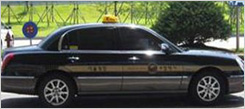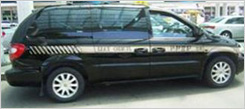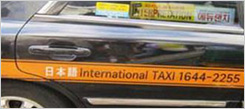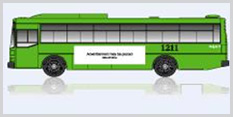Life in Korea
HOME > School Life > Life in Korea1. Traffic Information
1. Subway
지하철은 이용이 편리하고, 청결하며 운행간격이 짧아 가장 효율적인 교통수단입니다. 지하철 노선은 노선별로 색상이 다르며, 모든 역의 표지판은 한글, 영어, 한자로 표기되어 있습니다. 티머니(Tmoney)로 불리는 교통카드는 편의점에서 구입할 수 있습니다. 지하철 노선 간의 환승은 무료이며 티머니 소지자의 경우 버스와 지하철 간 환승도 무료입니다.
| Age | T-money | A single journey ticket |
|---|---|---|
| Adult | 1,250 KRW | 1,350 KRW |
| teenagers | 720 KRW | 1,350 KRW |
| Children | 450 KRW | 450 KRW |
※ Extra fee will be charged if you use Airport Railway and New District Line.
※ 10~40km: Additional 100 KRW will be charged for every 5km
※ Additional 100 KRW will be charged for every 8km after exceeding the first 50km.
※ If you use the transportation card, you will save 100 KRW for every journey.
1-1. How to use
| 1. The signs for subway stations are in Korean and English, along with the colors that symbolize the route, and each exit has a number. | |
 |
|
| 2. A single journey ticket can be purchased at local ticket vending machines. A deposit of 500 won is required. This amount will be returned if you return the card at the arrival station. (This process is not required if used as a T-Money transportation card). | |
 |
 |
 |
|
2. TAXI
All taxis use meters, and the basic fare varies slightly depending on whether you are traveling on a regular, international, modest or large scale. Most taxis charge you for cash, credit cards, and T-money. Fares vary depending on the type of taxi, distance traveled, and time.
| 종류 | 이미지 | 내용 |
|---|---|---|
| Common Taxi |

|
Common taxis can be categorized into standard(regular) taxis and deluxe taxis. |
| Deluxe Taxis |

|
Deluxe taxis, called Mobeom Taeksi in Korean, offer slightly more passenger space and a higher standard of service than regular taxis. This means that the fare is higher than regular taxis. |
| umbo Taxis |

|
A van taxi that can accommodate up to 8 passengers, convenient for larger groups and bulky luggage. |
| International Taxi |

|
International taxi driver for foreign tourists are fluent in English, Chinese, Japanese and other languages displayed on the side of taxi. |
3. BUS
Buses are cheap and convenient to use. Buses vary in color by route. The Blue Bus connects the different districts of Seoul City along the main road. The Green Bus connects the subway station, the bus connecting the Blue Bus to the residence and various residential areas, and the red bus connects the inner city with the suburbs.
| Bus Type | Adult | Teenagers | Children |
|---|---|---|---|
| Blue/Green Bus | 1,300 KRW | 1,300 KRW | 450 KRW |
| Red Bus | 2,400 KRW | 2,400 KRW | 1,200 KRW |
※ T-money card holders receive a discount of 100 KRW from the fare.
※ In the case of T-money holders, it is free up to 4 transfers are available for transfers between buses and between buses and subways. When you get off the bus, be sure to put your T-money card on the traffic card terminal at the front door or the back door.
※ Transit should be within 30 minutes (1 hour between 9 pm and 7 am) and within 10 km of the bus.
| Type | Photo | Contents |
|---|---|---|
| 간선버스 (BLUE BUS) |
 |
- 3-digit line bus that runs long distances in Seoul city - Timely interconnection between suburbs, urban centers |
| 지선버스 (GREEN BUS) |
 |
- Handling transit demand within the region, linking buses and subways with transit and traffic zones |
| 광역버스 (RED BUS) |
 |
- 4-digit number of wide area bus connecting Seoul and metropolitan cities by express [4 digits number system of Gwanghyeon division number + departure area + route serial number] |
For more information please visit the website – http://korean.visitseoul.net/essential-Info-article/서울의-교통수단_/408
2. Medical Insurance Scheme
According to the Ministry of Education, the regulation of “Foreign Student Medical Insurance Scheme Guidelines”, all the foreign students who have to stay more than 6 months in Korea, must join the Foreign Student Medical Insurance Scheme and its related clauses. Students who are studying in Center for Korean Language & Culture, Hankuk University of Foreign Studies must join the Foreign Student Medical Insurance Scheme in compulsory.
1. Cautions
Those who are not joining the Insurance :
Would not be issued any academic certificates; Would not be allowed to receive any scholarship; Would not allowed to receive or extent your visa; Would not be allowed to join any activity held by the university.
•For those students who had already applied medical insurance in their countries, Korean National Health Insurance, or from any private insurance company in Korea, must send the latest copy of insurance certificate to CKLC office.
2. Who should Apply for Insurances?
• For those students who will stay in Korea more than 6 months (D-4-1 Visa)
※ Except for the exchange students (Please inquire the Office of International Student Affairs)
• Other Visas Holders (C-3-1, H1, F-2, etc.) We encourage you to join the scheme but it is not compulsory to apply.
3. Types of Insurance (The following types are available to choose for application)
• National Health Insurance Service (The Republic of Korea)
• Private insurance companies which provide medical insurance for foreign students
• Overseas medical insurance (with full coverage on accident and illness) which could be effectively claimed in Korea (Included private insurance company)
4. Information of Private Korean Insurance Companies and the Application Procedures
[Application Procedures for Foreign Student]

※ Please visit the CKLC office if you want to get more information about other insurance companies
※ For example, normal insurance fee: 3 months (30,000 KRW) / 6 months (60,000 KRW)
3. Sightseeing in Korea
Information about Korea – http://korean.visitkorea.or.kr

Official Information from Seoul city – http://korean.visitseoul.net






